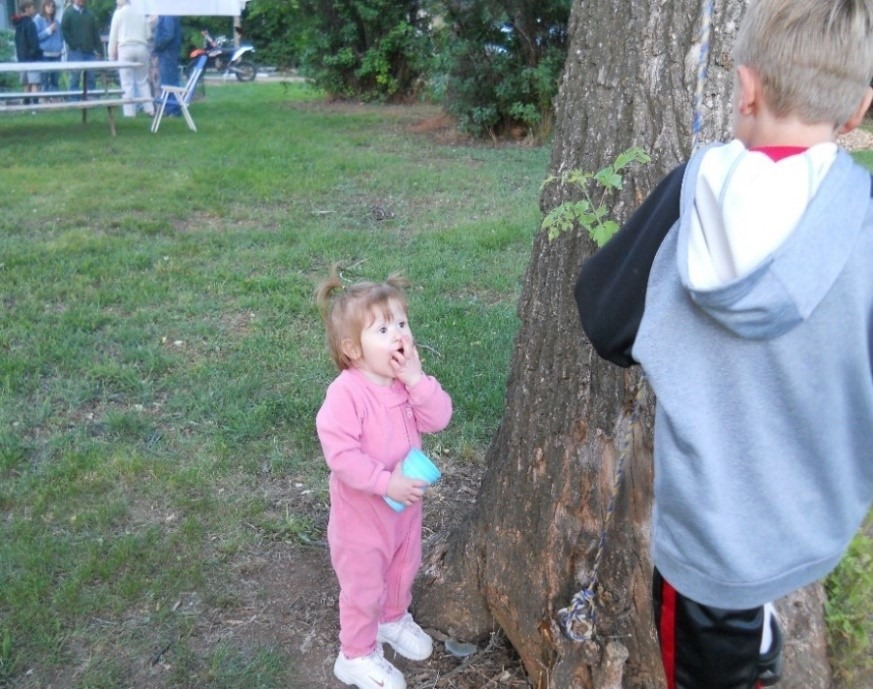By Erin Bush and Laura Lorenz
In Part 1 we explored critical and creative thinking in photovoice projects. In this sequel, we look at the ways that facilitators and clinicians can use specific strategies and tools to strengthen critical and creative thinking in photovoice projects. As we learned in Part 1, all stages of photovoice entail critical and creative thinking. Participants use these skills when a) choosing photos to take, b) sharing photos and providing feedback on others’, c) writing and sharing captions, d) receiving and considering feedback, and e) making decisions about where and how the work should be presented.
In Part 2, we suggest three practical strategies to foster critical and creative thinking with photovoice: 1) presenting thought-provoking ‘going deeper questions’ to the group, 2) finding words to share experiences and feelings, and 3) practicing low-stakes caption writing.
Going deeper questions
It can be helpful to have some provocative, follow-up questions in your ‘back pocket’ and use them as needed to encourage conversation. Early in your project, some participants will doubt their abilities. Use questions with your group or with individual participants to encourage talking and sharing.
- How do you see your role in the project?
- What might be the ideal end product for you? How can you contribute to that?
- What are you comfortable sharing about yourself?
- What is something unique that you know or have experienced that is different from the other group members?
These types of questions encourage creative thinking and may help the participant to see what their unique contribution is. Later on, as participants share their photos and captions, rich discussion can ensue! Some participants, however, will feel hesitant to share. Reminding participants of the project’s larger purpose can be helpful:
- What do people in our community need to know?
- Which photos will help our cause the most?
- Which pictures might have the most impact on our audience?
- Is there something you have always wanted people to know about your situation/condition?
Remind people that there are no right or wrong pictures, that photos can be literal or metaphorical, and that a photo can help to tell a story. Questions to support photo conversations include:
- Which pictures “say” the most to you?
- Which pictures are showing something surprising that the audience doesn’t expect?
- Which pictures tell a story that we want to share?
- What are some of the points we can make using our pictures?
These questions can also support decisions about which photos to include in your exhibit.
Finding words
Plan ahead to bolster photovoice conversations by creating a list of words relevant to your project topic. When people are struggling or frustrated, pull out your list and use it to facilitate ideas and conversation. With adolescents and participants living with intellectual disabilities use a word-generating exercise as a warm-up activity. Ask participants to say aloud some words that relate to your project topic while you record them on a white board, chalk board, or flip chart. Return to these words during photo discussions or when identifying themes across photos. Participants use creative thinking to generate words, and critical thinking to select a word they feel is best.
Photovoice projects can stimulate a wide range of emotions, and naming feelings can be hard. However, using a word to describe that feeling can help participants to feel understood and even empowered. Consider using an online tool such as the feeling wheel developed by Gloria Wilcoxi, to identify a specific word for an emotion. Wilcox created the wheel using colors to further represent emotions and help people identify and communicate their feelings. All three of the links below lead to feeling or emotion wheels that can support photo conversations:
- https://aca-arizona.org/wp-content/uploads/2013/02/650_Feelings-Wheel-Color.jpg
- https://i.pinimg.com/originals/11/01/73/1101739e7f0b286c5b516e4a48a385f2.jpg
- https://gramho.com/media/2325482851158884233
Low-stakes practice with captions
With Photovoice we are not left to guess what the photo represents because we can read the caption. Writing captions helps participants to communicate what the photos mean to them. Some people feel confident about writing, others will feel apprehensive and vulnerable. Provide low stakes practice with caption writing before asking participants to write their own. One strategy is to bring some general, non-topic photos to the group and ask participants to take turns describing how they might caption it. Start by modeling an example first. We provide two examples below:
Example 1: Practice with low-stakes caption writing

Example 2: Practice with low-stakes caption writing

Caption writing may still be difficult for some participants. A second strategy is to bring some ready-made captions for participants to choose from when discussing a general photo (not taken by a participant). Have a range of captions printed on strips of paper. Ask participants to choose a caption for a sample photo and explain why they chose it. This exercise can prepare participants living with intellectual disabilities, a communication disorder, or any condition that makes caption-writing a challenge, to talk and think about their own photos in a different way.
Participants will feel more excited about photovoice when the tasks are clear and they have a chance to practice. Writing captions is a critical and creative thinking activity that helps participants to take others’ perspectives into account, enrich their message, and enrich the project as a whole!
Conclusion
Photovoice projects cover a wide range of topics, yet challenges that arise are often similar. Project leaders may need to facilitate strategies that encourage creative and critical thinking to help participants feel more comfortable or confident about sharing. Strategies such as ‘going deeper’ questions can encourage group conversations and new ways of thinking about photos and the project topic. Using a feeling wheel to aid in formulating captions and themes can be helpful. Bringing some general photos and even pre-written captions can provide inspiration. Photovoice projects are designed to be inclusive. Everyone participating in your project wants to know – and feel – that their voice is being heard. We encourage you as facilitators and clinicians to use strategies and tools that can support meaningful participation and communication and critical and creative thinking by all.
More ideas for tools and strategies? Please comment below!
Erin Bush is an assistant professor in the Communication Disorders division at the University of Wyoming. Before attending the University of Nebraska Lincoln for her doctorate, Erin worked in medical and rehabilitation facilities as a speech-language pathologist. She teaches and conducts research regarding acquired neurogenic communication disorders, and her work has mostly been with people who have had a TBI, stroke, or other neurological condition such as Parkinson’s disease. She also has a specific interest in qualitative research methodologies. Erin attended the Photovoice Worldwide training in March and has been working with Laura since that time on blogs as well as an upcoming webinar about critical and creative thinking with photovoice!
Laura Lorenz is co-founder and educator at PhotovoiceWorldwide LLC. She has a PhD in health policy and health services research from Brandeis University and a Master of Education (Instructional Design/Adult Education) from the University of Massachusetts at Boston. Laura has been using photovoice since 2001 with girls, youth, people living with brain injury, older adults, and people living with mental illness. She has published in peer-review journals and books on disability, brain injury, health, healthcare, cost-effectiveness, managed care, rehabilitation, research involvement, sociology, visual education, and visual methods. She facilitates the professional development course ‘Talking with Pictures’: Photovoice.
i Wilcox, G. (1982). The Feeling Wheel: A tool for expanding awareness of emotions and increasing spontaneity and intimacy. Transactional Analysis Journal, 12(4), 274-276.
